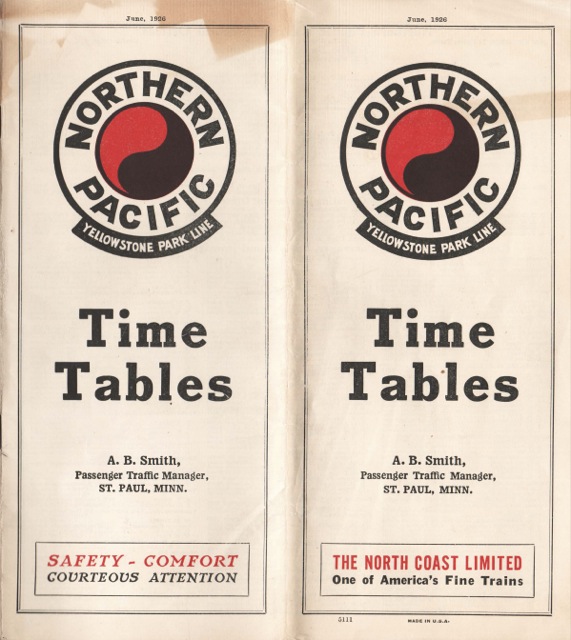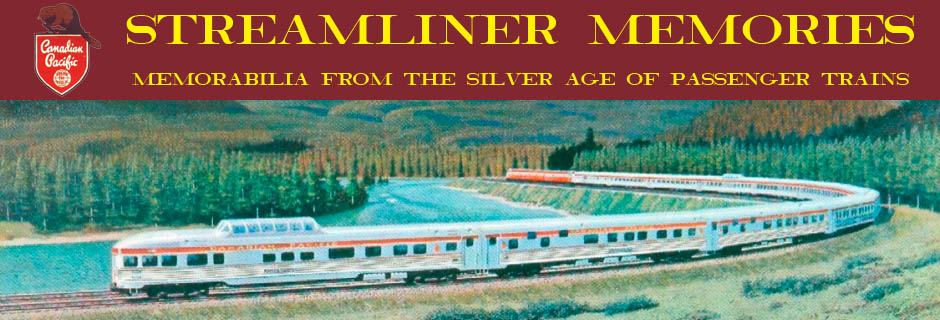This 88-year-old timetable reveals that the Northern Pacific had quite a range of trains in the Golden Age of rail travel. Trains 1 and 2 were the Chicago-Seattle North Coast Limited, which left its respective endpoints each morning and arrived at the opposite end slightly less than 72 hours later. Trains 3 and 4 were at that time called the Pacific Express and Atlantic Express, and they left their endpoints in the evenings and arrived at the opposite ends slightly more than 72 hours later.

Click image to download a 26.6-MB PDF of this timetable. Click here to download an OCRed version.
This is a summer timetable, and in the summers the all-Pullman Yellowstone Comet. Strangely, it wasn’t identified in the timetables by number, but it might have been 5 and 6 considering no other trains in the timetable have those numbers. The Comet trailed about five minutes behind the North Coast Limited from Chicago to Livingston, arriving there at 3 am. In order to give passengers a chance to see the scenery from the open-side observation cars, the train then sat in Livingston until 9 am, when it headed for Gardiner and the north entrance to Yellowstone Park, arriving at 11:15 am.
Eastbound, the train left Gardiner at 7:30 pm, arriving in Livingston at 9:45 pm. After a two-and-a-quarter hour layover, the train left Livingston one minute after midnight. Although this was two-and-one-half hours before the Atlantic Express, the Comet only managed to arrive in Minneapolis and St. Paul 25 minutes before the Atlantic.
Trains 41 and 42 were a third transcontinental that extended from Kansas City to Billings over the Burlington and then Billings to Seattle on the NP. Westbound, this train left Billings almost two hours before the North Coast Limited. Somewhere along the Clark Fork River between Garrison and Missoula, the North Coast Limited overtook the Kansas City train, eventually arriving in Seattle two hours before the Kansas City train.
Eastbound, the Kansas City train left Seattle two-and-one-half hours before the Atlantic Express, and manages to stay ahead of the latter train until Logan, Montana. The two trains somehow have identical schedules from Logan to Bozeman, then the Atlantic pulls ahead on the way to Livingston and manages to arrive in Billings more than an hour before the Kansas City train.
Trains 7 and 8 were local trains that stopped at every little town between St. Paul and Glendive, Montana. Other local trains served much of NP’s main line west of Glendive:
- Trains 187 and 188 went from Glendive to Billings;
- Trains 219 and 220 went from Billings to Butte;
- Trains 257 and 256 went from Butte to Missoula;
- Trains 273 and 274 went from Missoula to Dixon and then off the main line to Polson;
- Motorcars 305 and 306 went from Kootenai to Spokane; and
- Trains 333 and 334 went from Spokane to Seattle.
Few of these locals had convenient connections with one another, and someone curious enough to take locals from St. Paul to Seattle would require at least 7-1/2 days to do so, as opposed to 2-1/2 on one of the through trains. But the locals meant that most of the main line was served by at least four trains a day in each direction. One notable exception was the segment from Dixon to Kootenai, served by only trains 1 & 2, 3 & 4, and 41 & 42. In addition, the NP route between Logan and Garrison, Montana, split, with one route going to Helena and the other to Butte. With locals, each route still had three trains a day.
Midwesterners going to Yellowstone who didn’t want to take the Comet–which had neither coaches nor tourist sleepers–would find it most convenient to take the Pacific Express, which would put them in Livingston at 2:40 pm and Gardiner at 5:15 pm. Returning, however, they would probably prefer the North Coast Limited, which left Livingston at 4:04 pm and require them to leave Gardiner on a train at 11:45 am. This route would avoid the westbound North Coast Limited‘s Livingston arrival at 2:53 am and the eastbound Atlantic Express‘ departure at 2:32 am.
NP had plenty of other trains in 1926, but these are the main ones. Curiously, the timetable includes a full-page ad for Astoria, which isn’t on the NP but on its half-owned subsidiary, the SP&S. I have to wonder if this ad was inspired by the publicity given to Astoria by SP&S co-owner Great Northern’s Columbia River Historical Expedition, which took place in the summer of 1926. It seems unlikely, since the expedition hadn’t taken place when this timetable was put together, but it seems strange that NP would devote a whole page to Astoria when so many other fascinating cities on its own lines were neglected.
